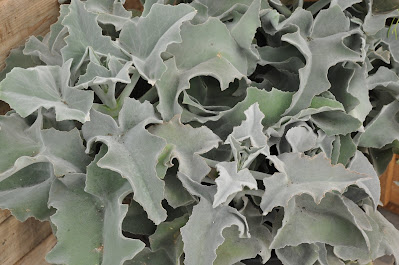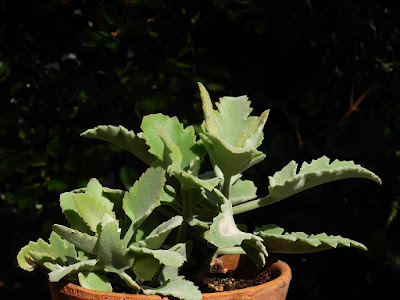Kalanchoe beharensis - Elephant's ear kalanchoe are resistant to disease and insects but if kept outdoors, could eventually be affected by aphids...
Kalanchoe beharensis, also called as Elephant's ear kalanchoe, Felt bush, Kalanchoe vantieghemii, is a species of the genus Kalanchoe. This species was described by Emmanuel Drake del Castillo in 1903. The name of the species is given due to the specific epithet concerning the town “Behara” in Madagascar where this succulent grows in wild.
IDENTIFY KALANCHOE BEHARENSIS - ELEPHANT'S EAR KALANCHOE
Kalanchoe beharensis is native to Madagascar. It grows wild in Behara region of South Madagascar and prefers to grow in several types of soils in xerophyte conditions (conditions from minimal no water at all).
It is a succulent tree-like shrub which reaching 12 feet (3 m) in height under the right conditions. The large opposite leaves are triangular, nearly hastate, and irregularly lobed, reaching from 5-14 inches (12.5-35 cm) long by 3-14 inches (7.6-35 cm) wide. Leaves are covered with dense felt-like hairs with mature leaves having a rusty color on top and silvery underneath. Leaves are usually crowded at the tips of branches.
Elephant's ear kalanchoe blooms in spring to summer form on terminal racemes with small flowers. The flowers are urn-shaped, greenish-yellow, 6mm in length and are not particularly showy. Growing the Felt Bush outside of the native area may impact its flower production. You may not see the flowers at all when grown outside.
This species is completely nontoxic to humans. But it can be toxic to pet cats, and livestock. According to the National Animal Poison Information network, it is not poisonous to dogs if the plant is not treated with any chemicals. Your pet cats may experience serious conditions after ingesting the plant. The cardiac glycosides in this plant are toxic to animals and can lead to serious symptoms such as a change in heart rate, rhythm, excessive salivation, and stomach upset. The toxicity will depend upon how much part of the plant your animal has ingested. Keep the plants out of the reach of your animals. In case your pet accidentally ingests any part of the plant, consult a Veterinarian as soon as possible.
KALANCHOE BEHARENSIS - ELEPHANT'S EAR KALANCHOE CARE AND CULTURE
Cultural information should only be used as a guide, and should be to be adapted to suit you. Your physical location; where you grow your plants, how much time you have to devote to their care, and many other factors, will need to be taken into account. Only then can you decide on the cultural methods that best suit you and your plants.
Light:
Kalanchoe beharensis can grow in full to partial sun, a southern, eastern or western exposure. During summer do not allow direct sunlight because its leaves who contain lots of water will get sun-burned. Direct sunlight from fall till early spring will not harm your plant.
Temperature:
Elephant's ear kalanchoe grow best at the optimum temperatures range between 64 and 68 °F (18 and 20 °C) day and night. If temperatures are under 61 °F (16 °C) day and night, this can delay plant growth and development and may cause blind eyes or no flowering. It is very sensitive to cold and it takes only a few hours of near 40 °F (4 °C) for the plant to die. Avoid placing it near drafts or cool windowsills.
Substrate and growing media:
Kalanchoe beharensis can be grown in 2.5-inches, 4-inches or 6-inches pots with the rooting media and subsequent growing media that are fast draining and high in organic matter. Their root system is extremely sensitive and it would be advisable to use clay pots that allow better aeration of the roots. Ensure excellent drainage by placing pebbles at the bottom of the pot and use light soil containing lots of peat moss, perlite and sand.
The plants love to be alone in small pots. However, the larger the pot the larger the leaves but the size of the top will hardly affect blooming or rate of growth. Avoid planting companion plants in the same pot and repot each spring adding fresh soil.
The pH is also critical and should be in the 6.0 to 6.5 range. The plants are sensitive to zinc deficiency, which can be aggravated by high phosphorous. But at this pH range, both zinc and phosphorous should be available at suitable levels. They also have high calcium requirements.
Watering:
Elephant's ear kalanchoe like water only when the top level of their soil is dry. Wet soil should be avoided. The most common mistake people make is overwatering which can cause the roots to rot. You can easily prevent this by allowing your plant to dry out completely before watering. The foliage should be kept as dry as possible and, therefore, using a system, such as drip irrigation, is best.
Fertilizer:
Fertilize the plants with ratio 3:1:3 (N:P:K) until bud formation. During the flowering period, the ratio should change to 2:1:4 or 3:1:4. It may be necessary to make supplemental applications of major elements, including calcium and magnesium and trace elements, particularly iron and manganese.
Pruning:
Little or no pruning is necessary for many years. If needed, pruning should be done immediately after flowering. When pruning, simply pinch or clip them back where they attach to the stem. Pinch out dead flowers regularly to stimulate new flowers to form.
Many of the new cultivars have good basal branching, so no pinching is required, which was a very labor-intensive project necessary with the older cultivars. However, if a cultivar requires pinching to encourage branching, today the plants are normally treated with growth regulators.
Rest period:
When the flowers start to die back, cut them off and let the plant rest. After deadheading, you should reduce watering as the plant will need less water during this resting period. Soon you will notice new buds and your plant will bloom again. This change in blooming and resting cycles will go on throughout the year irrelevant to seasons.
Pests and diseases:
Kalanchoe beharensis are resistant to disease and insects but if kept outdoors, could eventually be affected by aphids, scale, spider mites and nematodes. Common symptoms include apart from insects themselves on the crossing of the stems or the undersides of leaves, the presence of honeydew on leaves, creased faded leaves and webs, or leaves that look torn or bitten. Prefer non-toxic treatments because the plants are very sensitive to certain ingredients used largely in insecticides widely used. If you decide to buy a chemical insecticide do tell the nursery that you are planning to use it on a plant.
Propagation:
Elephant's ear kalanchoe is usually propagated by cuttings. Cuttings normally root in about three weeks during the summer months and four to six weeks in the winter at temperatures of 70 to 74 °F (21 to 23 °C). Using bottom heat may increase rooting speed.
















COMMENTS